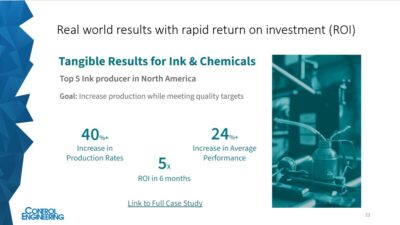Ask Control Engineering: How can variable speed drives increase efficiency? Links to resources on variable speed drives are provided below.

Ask Control Engineering: How can variable frequency drives (VFDs) increase efficiency?
Answer: Variable frequency drives, like many technologies in discrete manufacturing, have gone through a number of transformations in the last several years to improve their ability to operate and function on the plant floor.
In the past, when a drive indicated a trip condition, the user was left to largely guess at what had caused the condition. Modern VFDs are designed to alert users to not only the exact cause of a trip condition but can record conditions leading up to the trip that may indicate entirely different causes for that eventual trip. So not only are VFDs to be more efficient, but they are designed to provide an added layer of safety for workers. This is especially important for those working in chemical, oil and gas, and mining operations, among others.
See related articles linked below on variable frequency drives.
Tom Lowery explains that VFDs designed to incorporate communication are able to achieve much higher efficiency along with process improvement by understanding in greater detail where and why power consumption varies. Evolving technologies that increase process efficiency and provide detailed information on energy use have helped, offering greater insight into the level of efficiency for their respective processes.
Dr. Markus Erlich explains how drive software can suppress machine vibration and the benefits of this technology include improving the cycle time and performance of machines in applications such as electronics assembly, semiconductors, machine tools, and laboratory automation. Advanced vibration suppression control used in servo drives can quickly stabilize systems that develop vibrations at a constant frequency. Proprietary control algorithms reduce the following error and the settling time of the load.
Sean Gaffney talks about how important it is to select the right VFD for your plant. The most important aspect, he says, is not the more current. Rather, it’s the motor horsepower that is the key aspect to look into. When selecting a permanent magnet synchronous (PM) motor for an application, it is important to understand that they require VFDs to operate. PM motors, which typically have higher current values than the premium efficiency specifications, have a power factor that is very close to unity. PM motors have historically been used for specialized applications that require either very high operating speeds or high torque at lower speeds.
Jeb Moulton explains how electromagnetic interference (EMI) and radio frequency interference (RFI) in automated machinery can negatively affect operations. Even with proper precautions, it is likely that EMI and RFI will be present in automated machinery, so components should be properly shielded. Solutions to mitigating EMI and RFI include a metal enclosure design and a proper layout that keeps power and signal components and wiring separate. Adding an EMI filter to mitigate electrical noise in automated equipment is useful, as well.
Shady Yehia explains some of the benefits of a VFD aeration control strategy for a wastewater treatment plant. Some of the benefits include:
- Reduction in maintenance costs, by removing the control valve, a component with a high demand on maintenance resources.
- Faster, more accurate and more responsive control, which often leads to reduced process variability and also ensures that the water is within the requirements of the process at all times.
- Enhancement of the plant power factor, as VFDs contain internal capacitors that supply most of the reactive power requirements of the motors they drive.
– Chris Vavra is production editor, Control Engineering, CFE Media, [email protected].
ONLINE extra
– See the Control Engineering cyber security page.



